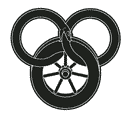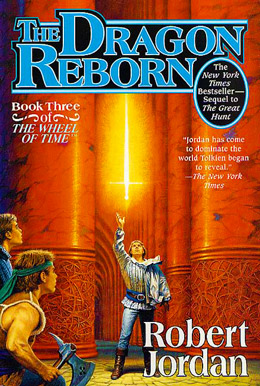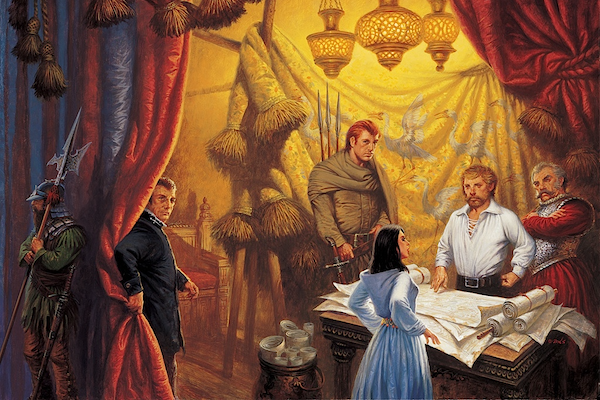You think you’re all that, Wheel of Time Reread Redux, but you’re… well, no, you kinda are in my book. Mwah!
Today’s Redux post will cover Chapters 50 and 51 of The Dragon Reborn, originally reread in this post.
All original posts are listed in The Wheel of Time Reread Index here, and all Redux posts will also be archived there as well. (The Wheel of Time Master Index, as always, is here, which has links to news, reviews, interviews, and all manner of information about the Wheel of Time in general on Tor.com.)
The Wheel of Time Reread is also available as an e-book series! Yay!
All Reread Redux posts will contain spoilers for the entire Wheel of Time series, so if you haven’t read, read at your own risk.
And now, the post!
Chapter 50: The Hammer
 Redux Commentary
Redux Commentary
So back when I was originally doing this Reread, I made the mistake of assuming that most people who were reading had already read the WOTFAQ, which in retrospect may have been a weensy bit arrogant and/or ignorant of me. But regardless of why I made it, that assumption is why I didn’t bother to mention a lot of things in the earlier books that I felt had already been adequately covered in the FAQ, even if they were pretty interesting.
Like The Alleged Big Metallurgy Mistake in this chapter, for instance:
As soon as [Perrin] had made the hot-cut, he tossed the glowing metal into the salted quenching barrel. Unsalted gave a harder quench, for the hardest metal, while the oil gave the softest, for good knives.
According to WOTFAQ contributors Jon Palmer and Don Harlow, this is: “Wrong. In order of resultant hardness, it goes Oil, Water, Salt Water, with Salt water yielding the hardest blade because of best heat transfer and higher boiling point than plain water. Oil is softer because of slower heat transfer but is commonly used for cutlery because it causes less thermal stresses and a tougher blade. (won’t break from shock) Salt water quench is definitely a harder quench than fresh water. It’s due to the higher boiling point of salt water precluding the formation of an insulating vapor layer over the steel which slows heat transfer from the steel to the water.”
I am not a metallurgist, nor a blacksmith, nor do I play either one on the Internet (AS FAR AS YOU KNOW), but even I know that salt water does indeed have a higher boiling point than fresh water. Whether that fact confirms that Jordan made a mistake here, though, I have no idea. However, no one has ever contested this assertion in the FAQ to my knowledge, so I have to assume that, fandom being an ornery and quick-to-jump-on-mistakes-about-mistakes bunch, the lack of outcry over it indicates that Messieurs Palmer and Harlow were in fact correct, and Jordan slipped up here. Whoops.
I also don’t know whether this error was corrected in later editions of TDR, as some gaffes the fans so helpfully pointed out were. I don’t honestly think it makes much difference on a grand scale whether it was corrected or not, but I remember this tidbit fondly nevertheless. Mainly because I learned more about smithing from the discussion about this gaffe than I ever would have otherwise, probably, and I have a certain gleeful appreciation of information acquired by arcane or bizarre methods. It’s just so much more fun to learn things that way.
“Information acquired by arcane or bizarre methods” is a phrase which, incidentally, can apply to a nearly worrying amount of knowledge I consider essential to my overall education, but which I only acquired because I spent an inordinate amount of time on the Internet arguing with random people about a certain epic fantasy series. I mean, don’t get me wrong, I loved it (still do love it), but I can’t help feeling that maybe I should have gotten a lot more of said knowledge from the education I actually paid for, you know?
Oh well.
Other than that, I think my original commentary covers this chapter pretty well. The only other thing worth noting there is this bit of my thoughts:
It’s also a very smooth segue into what will become Perrin’s central dilemma for the series: the axe vs. the hammer, or war/destruction/brutality versus peace/construction/beauty. I’ve never been sure, personally, whether the fact that the hammer is just as capable of being used as a weapon as the axe (and that Perrin does actually use it as such, more than once) undermines this dichotomy or not.
And now that the series is over, I… still don’t know the answer to that question, really. Especially when you consider that technically the axe is an implement with dual functionality as well. Obviously it makes a fearsome weapon, but you know, I imagine it’s rather difficult to stoke a forge fire (for example) if you don’t have an axe to chop the wood for it.
So, the comparison is maybe a little shaky on that basis. But, you know, it’s all symbolic and shit, okay, and probably I shouldn’t overthink it to that extent. Because even if you can quibble with it around the pedantic edges, the central dilemma itself is still relevant. Which is something I admit even while acknowledging how incredibly impatient I got with Perrin’s struggles over that dichotomy at several points.
Because, hey. That hammer-forging scene in TOM? Made it all okay, with the sheer power of its awesomeness. Yep.
Chapter 51: Bait for the Net
 Redux Commentary
Redux Commentary
Hahaha oh wow. So, in the original commentary I complained about not understanding how the whole 13 Fades + 13 Darkfriend channelers = Turn You EEEEvil thing worked (which, to be fair, had not been really explained at the time in the books), and laughed at the idea that it was like The Attitudinator, and oh yeah I had totally been on a giant Kim Possible kick at the time, hadn’t I. (That was actually a really cute and clever show, I should rewatch that sometime.)
But of course, it turns out the joke’s on me, as it transpires that the 13×13 trick is more or less exactly like the effects of The Attitudinator. And in fact I should have known that even back then, as one of my intrepid commenters on that post pointed out: “Jordan explained way back in one of his Q&A’s that it involved the worst aspects of each individual being targeted and magnified until they utterly dominated the personality, and in effect, the individual would WANT to serve the Shadow of their own ‘free will.’”
Commenter Litg also opined that the notion was one of Jordan’s creepier concepts. And, having now gotten to see it in action in TOM/AMOL, I have absolutely no quarrel with that assessment. Eeeeeeeeeek
Ugh, so disturbing. Once again, have absolutely no criticisms to offer re: Nynaeve and Elayne screaming their heads off at the idea. Or Egwene fighting until they physically knocked her out, either.
Liandrin laughed. Tangling a hand in Sandar’s black hair, she wrenched his head back. He stared up at her with the eyes of a faithful hound—or of a cur expecting a kick. “Do not be too hard on this man.” She even made “man” sound like “dog.” “He had to be… persuaded… to serve. But I am very good at persuading, no?” She laughed again.
Sandar turned a confused stare on Nynaeve. “I had to do it, Mistress Maryim. I… had to.” Liandrin twisted his hair, and his eyes went back to her, the anxious hound’s once more.
Light! Nynaeve thought. What did they do to him? What are they going to do to us?
And this bit was, honestly, only slightly less disturbing than the 13×13 thing, in retrospect. “Slightly less” in that at least Liandrin’s half-assed version of Compulsion wasn’t permanent. Hell, even full-bore, non-half-assed Compulsion’s one bright side is that it can be shaken off eventually, as Morgase proved. Not without damage and trauma, of course, but it is possible. Whereas the 13×13 trick is, as far as I recall from what we’re told and shown, irreversible. That is some serious I Have No Mouth And I Must Scream nightmare fuel shit, right there, if you really consider it.
I also must say that I gave Nynaeve kudos, initially, for immediately understanding that Juilin’s betrayal of them was not actually his fault. Of course, it would have been nice had she or Elayne or Egwene actually conveyed that sentiment to Juilin himself, later. So in retrospect my approval for Nynaeve was soured a little bit.
That said, I did still totally love how she did her level best to beat the shit out of Liandrin and Rianna before they subdued her. And it was definitely telling that neither Black sister even thought to restrain Nynaeve bodily once they had her shielded from the Power, like it never even occurred to either of them that a channeler might also be able to resist physically as well as magically. I’m completely positive that there is a proverb or quotation somewhere that sums up the danger of such blinkered tactical thinking, but I can’t think of it. It’s probably Sun Tzu, the big showoff.
If you know which quote it is, though, let me know! But in the meantime, this is where we stop. Come back next week for what should be the penultimate post on TDR. Cheers!















I mentioned this a few days ago on the Part 23 re-read post. So I will mention it again. I recently learned that in Buddhism, the color yellow represents mercy and healing. Having learned this fact, I do not think it is a coincidence that RJ gave the Aes Sedai ajah dedicated to healing the color of yellow.
Nynaeve uses a channeler’s prejudice against a physical attack at least once more in the series. During her first battle with Moghedien, Nynaeve throws the sad bracelet at Moghedien. This has the effect of distracting Moghedien ever so much that Nynaeve is able to shield her. Similarly, when Egwene is shielded by the Sharan in Kandor, she reacts reaches for her belt knife (before Leilwin saves Egwene).
Thanks for reading my musings.
AndrewHB
Not restraining a shielded channeler is kind of a hallmark of the Black Ajah for the entire series. From the black sister in New Spring to here to Elayne’s-Stupid-Excursion Mk I and Mk II (the arrest and the failed bluff in the dungeon).
At least they’re consistent.
Both axe and hammer can be a tool or a weapon, but the versions Perrin has are a war axe and a blacksmith hammer. Maybe his Mjölnir is a synthesis of both options because it is a war hammer.
How does Loial exactly remember what he read in which book?
birgit @3–Regarding your Loial question: Because he’s Just. That. Awesome. :D
RE: the whole “compulsion can be shaken off” deal, that has more to do with how hard a person gets hit by it, doesn’t it? Liandrin wanted Juilin to come off as normal to lure Nynaeve and company into a trap and Rahvin needed to keep Morgase looking queenly, as it would draw too much attention to have her brain-dead while some random dude suddenly took over.
But I remember in many Graendal chapters that her compulsion toys were essentially brain-wiped to be nothing but in thrall to her and the narration seemed to indicate they were empty shells with nothing to them other than adoration to her, which led me to think that strong enough compulsion was the sort of thing that couldn’t be dispelled.
@5, you are right about the level of Compulsion that Graendal uses. Remember the messenger in TGS died once his compulsion was healed by Nynaeve. Graendal leaves nothing of note in the mind.
Regarding the hammer vs ax debate. I always took it that even if you are using an ax productively, like chopping wood for your forge fire, you are still destroying with it. The hammer can be used to destroy/kill, but can also create. The ax can only destroy/kill. That is what it is created for.
I looked up “chamfer” and learned something new: https://en.wikipedia.org/wiki/Chamfer
“High Lord Samon”…now I can’t stop picturing Be’lal as a giant salmon. xD
Envy of Lews Therin is a recurring pattern for the Forsaken. Weirdos.
Where would those 13 Myrddraal come from, and how? The Blight, via the Ways? The horde that eventually attacks the Stone of Tear was smuggled on barges, but it seems early for them to be there already.
*grin* My obsessions with WoT and Kim Possible happened to peak simultaneously when I was 16. Good good times.
KimPossible rewatch confirmed.
@7 – Can’t Myrddraal travel through shadows?
It’s not so much “I have no outh and I must scream,” as “I have no mouth and don’t care to scream.”
Which is a bit creepier in my head.
The limits of shadow travel are never explained, but there probably is a range limit, or Myrddraal would be attacking more southern areas.
@9 I don’t think it means they can straight up teleport like Travelling though. Lan says that he can feel a Myrddraal fading into the distance in the first book, implying they can just ‘hop’ from shadow to shadow, but not do so over great ranges.
*checks Theoryland and the WoT Wikia* Doesn’t say. Now I’m really curious. Grumble.
Bah. For me, RJ hit the sweet spot with his wildlife — enough information to spark ponderings, and enough mystery to keep them going.
I remember for a long time, I thought that the 13×13 Attitudinator trick had to be performed by dreadlords actually linked together because of the use of the term circle several times in describing the process, but this was shown in The Memory of Light to not be the case. You just need 13 of them with 13 fades channeling individually at the poor victim. Creepy, but I still like my interpretation that you need to link.
Interesting details about blacksmithing, I never knew about the supposed gaffe, but RJ always provided more than enough detail for me, especially compared to most fantasy authors.
I like the hammer/axe dichotomy because its just so personal. There’s no pure answer true for all of humanity, it’s Perrin looking for a way that works for him. It’s the sort of struggle I think high fantasy tends to neglect with its battles between good and evil. If Perrin had been a woodcutter the ordeal could have been opposite.
The mace much beloved of various Mediaeval churchmen because it did not “shed” blood, was a version of the club. The war hammer is just another version of the club.
Likewise the axe is just a version of the original stone axe, with a wooden haft on it to increase the head’s impact against any given object.
You’re right, it is all in Perrin’s mind. He’s used the axe he’s got purely and simply as a weapon, and he’s used the hammer primarily as a tool of making. He can adapt the hammer to be a war hammer but he’s only “comfortable” with his axe as a weapon.
Back in the old WoT FPS computer game, Fades really abused their shadow-hopping powers. It made them a dangerous and interesting enemy, since they could fade into a shadow just before you hit them with a fireball, only to appear in another shadow behind you with their crossbows at the ready. In that game, fading wasn’t instant, but it was very quick, maybe half a second, and it was kind of like someone side-stepping through a doorway, IIRC.
Regarding maces and clergy, here’s an interesting link: http://l-clausewitz.livejournal.com/394539.html
Maces were widely popular, first in the Romano-Byzantine army, and later in Europe and the Middle East more widely, not because clergy used them to get around any blood-shedding prohibitions, but because people began to use increasingly heavier armor. Besides, if you bashed someone on the head with a mace, I guarantee that you’ll see blood, even moreso if the mace were flanged or spiked, since those were particularly designed to punch through things (ranging from armor to skulls) and would surely cause significant flow of blood.
I suspect Perrin’s ax-hammer conflict has more to do with legend than with historical misunderstandings. Blacksmiths throughout most of the world were widely viewed as mystical, and often considered something close to sacrosanct (see the Aiel view of blacksmiths). Their ability to shape metal using fire and a hammer was hugely important, and those who knew the secrets of forming the best blades and the highest quality steels would have been worth more than their weight in gold. Contrast that, symbolized by the smith’s hammer, with the vaguely berserker-like way that Perrin fought when using his ax, and you see a harsh dichotomy between a sacred, mystical, creative force and a wild, uncontrolled, destructive one.
@14 – me too – I assumed that it was an actual channeling circle of Dreadlords and Mydraal (although the Mydraal) wouldn’t actually be channeling, I suppose. Somehow that seems a bit creepier.
The hammer/axe debate is probably mostly symbolism on a personal level for Perrin. His experience with the hammer is to build and create and represents his former life in Two Rivers. His main experience with the axe was in battle. I still find it (as plodding as it was) one of my favorite character arcs in the series (I found Perrin more compelling than either Rand or Mat, although once the series ends both of them have some pretty good arcs too).
re: axe vs. hammer
I think the image works, because what Perrin is angsting over is a battle axe vs. a blacksmith’s hammer. The axe was made for killing and, while technically possible, would have only limited use as a tool for chopping wood. The hammer, on the other hand, is first and foremost a tool. Like the axe it can be and is misappropriated as Perrin uses it as a weapon but it is still not as effective as an actual purpose-built weapon.
Once Perrin finds his balance between killing and creating he also finds his balance in his weaponry by creating Mah’alleinir, a war hammer, a fusion of weapon and tool.
Ah, the irony: Perrin talks about being glad he hasn’t met the hawk or a Tuatha’an with a sword, but it’s right here in Tear that he will meet Berelain, and of course not long after that he goes back to the Two Rivers where he meets Aram again. And of course, he’s quite right to want avoid both encounters, as it turns out. Also I don’t know which is funnier, Faile being even more upset about what she’s gotten herself tangled in or her getting after Perrin for sounding like Moiraine.
Perrin noticing the heat now but not back in the Blight: I suspect that this is a function of Perrin being very distracted by the Blight itself and the creatures in it; he was too busy watching everything so it wouldn’t kill him, and then fighting for his life, to feel the heat, but here in Tear the anxiety and uncertainty about Rand, then Be’lal, makes it harder for him to be unaware of the heat. Also it’s possible the heat of the Blight is magical in nature (since it’s generated by the Dark One, after all) and so his magical wolfbrother nature can tune it out as a matter of course, but Tear’s heat is all natural (and also possibly stronger due to Tear being about as tropical as Illian).
While the scene at the blacksmith’s does bring the hilarity of Faile’s comment (what, she thought Lan called Perrin “blacksmith” for kicks, or just because he looked the part?), I do love it overall for being that slice-of-life Leigh originally described it as. I also love how much it stresses not just Perrin’s love of and preference for creation, but foreshadows what he will hopefully still get to be someday. Because despite ending up as Lord of the Two Rivers, I highly doubt he’ll ever stop blacksmithing on the side. Also of course, the “if I have ever seen anyone made to hold a smith’s hammer, it is you” brings such a shiver of excitement and anticipation for ToM!
As for the metallurgy mistake, I’m not sure if that was corrected or not. I know it isn’t mentioned in the errata section of the WOT Encyclopaedia, and the updated version of the WOTFAQ doesn’t include such a section anymore. I seem to recall it was corrected though.
One interesting side note: when Ajala made that comment, it reminded me of the Hero of the Horn we get introduced to briefly at the Last Battle, Hend the Striker, whom many believe to be John Henry (and based on his description I think that’s confirmed). And that makes me think it’s a shame he and Perrin never got to meet, since even aside from the hammer commonality, I think they’d get along very well.
So Moiraine once again proves her awesomeness by ferreting out that Samon was Be’lal (again I think she must have listened in with her kesiera–while we don’t know who Sammael might have spoken to that would have revealed his real identity, we know Samon is the Stone with the Black Ajah and will be summoning Fades for Turning Rand/the girls; in either of those interactions he might well have been identified, either proudly giving his name to Liandrin and the coven or being called by name by a Fade).
And I have to say after seeing all Loial’s info about Be’lal’s cleverness and deviousness that while it fits Jordan’s general theme of the villains being Stupid Evil, I think it’s a shame that my personal crazy theory didn’t turn out to be true, that Be’lal either didn’t actually die (because he switched places with the real Taim) or that he was reincarnated and then took Taim’s place (because Jordan said the Dark One could bring back someone balefired if it had been a very small amount used, and Moiraine had noted she could only balefire someone back by a few seconds). Because otherwise it really does seem like a waste of a Forsaken; it doesn’t explain why Jordan included those details about the Dark One and Moiraine; and it would have made for a great call back if after having imprisoned (and threatened to Turn) Egwene here, Be’lal as Taim later got to be destroyed by her and the Flame of Tar Valon during the Last Battle. Full circle and all. Plus it would make Taim’s interest in Sakarnen match up with Be’lal’s desire for Callandor. Oh well, the canonical explanation does still make sense.
I am bemused by Moiraine’s comment about not knowing whether the appearance of the Aiel in Tear was “of the Pattern, or wrought by Be’lal.” Is she implying she thinks the Aiel are Darkfriends? Or just that he may have somehow lured or brought them there in order to fulfill the Prophecies? Either way, she’ll find out soon enough of the Aiel’s true allegiance.
As for the hammer/axe dichotomy, I think I have to agree: the fact both can be used for creation and destruction was surely not missed by Jordan, and this just makes the whole dilemma more realistic and complicated, but also that in the end, the hammer is still more creative than the axe and thus the final right choice for Perrin. The fact he has to make the choice is reflective of his past and home vs. his future, but the way he resolves it not only fits what the Pattern requires of him but also the different sides of himself. So in that case the fact axe and hammer can both create and destroy is even more appropriate.
I remember when Nynaeve ran into Sandar and he was acting strangely, alarm bells started going off in my head. But for some reason I didn’t connect the dots about Liandrin’s light Compulsion, so it still came as a shock to me. I think I know how Leigh feels about not always being able to see plot points coming! As for the capture itself…oh yes, I completely understand how Egwene felt and why she fought so hard. Aside from also having my hatred cemented not only for Liandrin but also Rianna and Joiya, I also recall that this is one of the few times we see the coven as being genuinely threatening (at least until the part at Full Moon Street in KoD). Probably because from here on out the Black Ajah is either sidelined/never allowed to cross paths with the Supergirls much, or because other bigger threats show up while at the same time the girls’ strength is continually growing. For example, while Nynaeve gets her scare with Temaile at the TAR Panarch’s Palace, and Jeaine’s use of the balefire rod is scary, the real major threat at that point is Moghedien. And she continues to overshadow them in TFoH. So, it’s nice to see how the villain threat level scales up accordingly, and that now, when the girls are still relatively weak, the Blacks are still frightening.
Of course a big part of that also comes from the Turning threat, which after seeing what it actually does in ToM and AMoL…holy hell. *shivers* Even if Liandrin knowing to scare the girls with it is contrived (having been told by Be’lal, who learned it from Mesaana, who either told Sheriam to tell Egwene about it or Sheriam told her she had done so), it’s still a very effectively chilling moment. And of course even if all of them (and Rand) were too strong-willed to be easily Turned, just the thought of it is… In any event, it’s very awesome to see Nynaeve fight back so strongly against such hateworthy villains, and I have to concur how the Blacks not even thinking of restraining Nynaeve is not only typical villainous arrogance but also typical Aes Sedai thinking regarding non-channelers. The fact it almost costs them their captives, or at least almost causes them physical harm, is rather delicious.
I too remember being glad Nynaeve realized Sandar hadn’t helped the Blacks willingly. And being annoyed that she seemed to have forgotten this when Sandar and Mat appear at their cell door. Still, she does listen, and believe and accept his explanation once he gives it, nor do I recall her ever treating him too badly after that (at least not in a way that has to do with his ‘betrayal’, more just him being a man), so there’s that.
@1 AndrewHB: Very good points!
@5 R0bert: Quite true. Leigh was obviously thinking only of Sandar and Morgase when she spoke of Compulsion being able to be shaken off. Although it’s important to note that Graendal does know how to do the lesser version that keeps people still acting and thinking mostly like themselves, since she uses it by necessity on the Great Captains.
@6 Jason_UmmaMacabre: Absolutely so, re: the hammer and axe.
@7 AeronaGreenjoy: Well, Lews Therin was the closest thing to a Big Good (seeing as how the Creator sits the series out, other than two moments), so it makes sense he’d be the focus of everyone, both Light and Shadow. Also it’s something of an irony, everyone envying the Lucifer figure when he himself doesn’t covet power and rulership the way Milton said Lucifer did with God. (Though Lews Therin did have some pride issues, as we know.)
And as others have said below, since the Myrddraal shadow-travel trick only works over short distances, they would have to arrive by some other means before being able to teleport into the Stone. At this point (since Shadowspawn can’t use Traveling), it must have been the Ways. This would explain why there would need to be such a wait for them to arrive.
@14 gadget: I thought that too! But it works either way.
@16 Aladdin_Sane: How ironic, then, that the main obstacles/antagonists Perrin keeps encountering, other than Slayer, are the Whitecloaks, this world’s version of the Church Militant!
@17 Porphyrogenitus: Very good points. And very interesting that while the hammer (even before he forges and names his Power-wrought one) and several aspects of Perrin’s character are reminiscent of Thor, the berserker way he fights with the axe is very much like the Vikings and other Nordic/Danish characters…which puts me in mind of the time and culture of Beowulf. That syncretization of myth and legend again!
@18 Lisamarie: Agreed on the symbolism.
@19 Randalator: I’m positive that fusion was absolutely intentional on Jordan/Sanderson’s part, to parallel Perrin coming to balance both sides of his nature via his training in TAR, facing Slayer, and eventually meeting Noam again.
macster @20
Taim as recycled Bel’al wouldn’t work anyway. Taim was a false dragon. And his false dragon-ness predated Logain’s, the tailend of whose false dragon-ness intersected with Rand’s path in Caemlyn.
Aerona Greenjoy @7
The army that attacks the Stone of Tear included Trollocs, IIRC. Hence the need for barges. While Myrdraal can probably go in and cause havoc commando-raid style, there’s far too few of them to really cause that much damage considering the army housed therein. This is I think, the same trouble with Borderland cities. Plenty of armed guards to ruin the day of any Myrdraal sneaking about.
Also, I always thought Moiraine having been able to identify any particular Forsaken through second hand sources(not like she’d risk herself getting within spitting distance) smacked of handwavium.
I know this is way late to the party, but could the quote you were thinking about (that channeler vs.channeler often forget about physical combat) be:
“I suppose it is tempting, if the only tool you have is a hammer, to treat everything as if it were a nail.” -Abraham Maslow.
I’m thought that a likely canidate since it’s a Trope Namer.
@alreadymad: I think you are misunderstanding me. Of course Taim predated Be’lal (though I think he was concurrent with or just after Logain). I was referring to the fact that at this point in the narrative he’s being held prisoner in Saldaea, in the next book we learn of Liandrin’s plan to free him, and then we learn of his escape just before the Tower coup, and so he was available for recruitment and replacement. The idea I had was that Be’lal had Taim brought to him at this point, let him die in the Stone disguised as himself, then went to Saldaea to take his place for the breakout. Or that Be’lal really died in TDR, but the Dark One placed his soul in Taim’s body after he was questioned and killed. So either way, the real Taim was around prior to this, and it was only post-escape (and from LOC onward) that he was Be’lal in disguise or re-souled. I did say it was a loony theory, but I think I had some good facts and reasoning to back it up. Oh well.